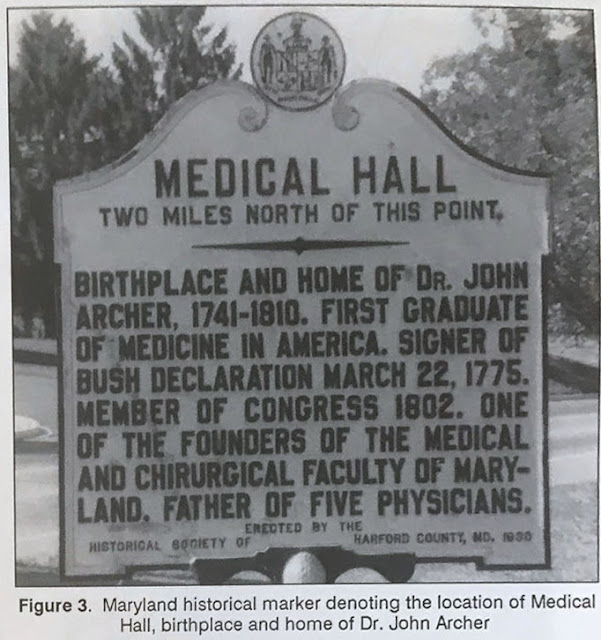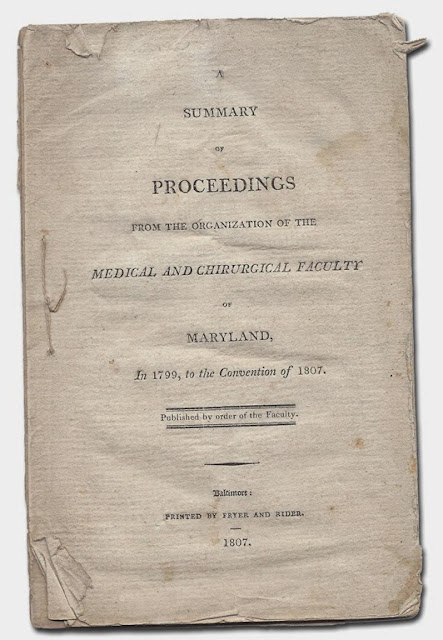“In all ages of the world, men engaged in the same pursuits
have united together for purposes of mutual advantage or protection.” So begins
Eugene Fauntleroy Cordell’s masterwork, “The Medical Annals of
Maryland, 1799 to 1899.”
Prior to the American Revolution, all but one of the Thirteen Colonies had a medical society. Although Maryland was one of the oldest colonies, it was the seventh state to establish a medical society.
In 1779, Dr. Charles Wiesenthal made the first
attempt at establishing a state-wide society of physicians, but the idea did
not catch on. In 1790, Dr. George Buchanan wrote a letter to the citizens of
Baltimore, and suggested the registration of deaths and the organization of a
humane society. Again, the idea did not catch the attention of the city’s
physicians.
However, many “physicians” objected to this proposal and the
original petitioners concluded that they were surrounded by “swarms of quacks.”
The petition was presented to the legislature, but it did not pass. At the
time, there were no formal medical schools in Baltimore, so Drs. Buchanan and
Wiesenthal began to lecture on the topics of anatomy, physiology, pathology,
and operative surgery.
In Harford County, a group including Dr. John Archer,
his sons and the students at Dr. Archer’s Medical Hall,The first attempt at organizing left an impression in the minds of physicians for more than a decade and in 1798, the organizing began again. Several physicians were recruited from each of the then-19 counties of Maryland, and from the
towns of Annapolis and Baltimore, and eventually they became the 101 founders. These men had trained at the best medical schools of the time – in Paris, Oxford, Edinburgh, and Dublin in Europe, and locally, in Philadelphia.In January of 1799, an act to establish and incorporate the Medical & Chirurgical Faculty in the State of Maryland finally secured the majority vote of the legislature.
The act directed physicians to promote and disseminate medical and chirurgical knowledge and prevent citizens from risking their lives at the hands of ignorant practitioners and pretenders to the medical arts.The first officers were to be
a President, Secretary, and Treasurer, as well as a 12-member Board of
Examiners “of the greatest chirurgical abilities in the State.” Seven of the
members would come from the Western Shore and five from the Eastern Shore.
Each person who was examined and received a medical license would pay the sum
of $10.00. Members elected to the Society would pay the same fee.
A name was given to the organization, and was declared to be “one community, corporation and body politic, known forever by and under the name of The Medical and Chirurgical Faculty of the State of Maryland.
The annual meetings were set for the first Monday in June, beginning in 1799 and then on the same date every other year afterward.However, nothing documents the first gathering of the group,
and it’s left up to Dr. Cordell’s imagination. He mentions that he has a
medical diary and notebook from Professor Nathaniel Potter from
1799, but the establishment of the organization is never discussed.
Additionally, for the first half century of the Faculty’s existance, there are very few records, save the brief “Summary of Proceedings” published in 1807.
The yearly Transactions weren’t published regularly until 1853.However, members published occasional papers and presented orations over the years and some of them remain in their original hand-written form.
Additionally, notices and advertisements were placed in local newspapers and medical journals, especially in Baltimore, document our earliest days.











Hello Meg--225 Years! No wonder they hired you, the Spirit of Baltimore, to keep track of it all, especially after Marcia flaked out on the job.
ReplyDelete--Jim
Awwww... thanks!
Delete